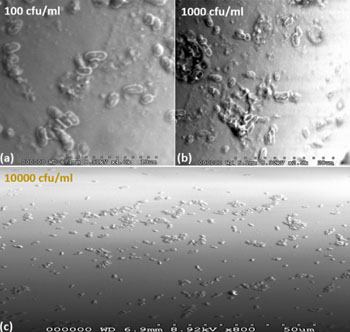Optical Sensor Could Help Fight Bacterial Infections
By HospiMedica International staff writers
Posted on 21 Sep 2016
A new sensor can detect the potentially deadly E.coli bacteria in just 15-20 minutes, much faster than traditional laboratory tests.Posted on 21 Sep 2016
Developed by researchers at the University of Quebec (UQO; Outaouais, Canada) and the Indian Institute of Technology Kanpur (IITK; India), the sensor is based on bacteriophages bonded to the surface of a germanio-silicate optical fiber via long-period fiber grating (LPFG). The sensor tip is placed in the tissue sample, where the bacteriophages latch onto lingering bacteria. When a beam of light strikes the surface, the presence of E.coli shifts the wavelength, a telltale sign of contamination. The overall length of the sensor is about 3.6 cm, making it suitable for bio-sensing applications.

Image: Scanning electron miocrographs (SEMs) showing bacterial binding on the sensor surface at different bacterial concentrations (Photo courtesy of IITK).
The sensor uses a novel and cost-effective method to compensate for the temperature-induced phase changes of LPFGs by selective excitation of the cladding modes of opposite dispersion characteristics. The resultant sensor is extremely sensitive to changes in ambient refractive indices, with a sensitivity of 1929 nm/RIU, over the ambient refractive index (ARI) range, and is capable of detecting an index variation of ∼5×10−6 RIU in the ARI with a negligible temperature sensitivity over a temperature variation of 40°C. The study was published in the September 15, 2016, issue of Optics Letters.
“Pathogenic bacterial infection is one of the biggest causes of death, and a fast response time is much needed for timely detection and subsequent cure of bacterial infection,” said study co-author physicist Saurabh Mani Tripathi, PhD, of IITK. “I'm excited by the very low time [our sensor needs] to accurately detect the presence of E. coli bacteria in water collected from environments at different temperatures.
“The temperature insensitivity makes the sensor more practical for outdoor applications, like on-site monitoring of water reservoirs. The food industry and pathology labs are other possible users of the new sensors; the sensor can be modified to detect other strains of bacteria by changing the bacteriophage,” concluded Dr. Tripathi. “Using currently available technologies, which are mostly based on amplification of the sample, it takes several hours to days to detect the presence of bacteria. A fast and accurate detection alternative is, therefore, preferable over the existing technology.”
Related Links:
University of Quebec
Indian Institute of Technology Kanpur














